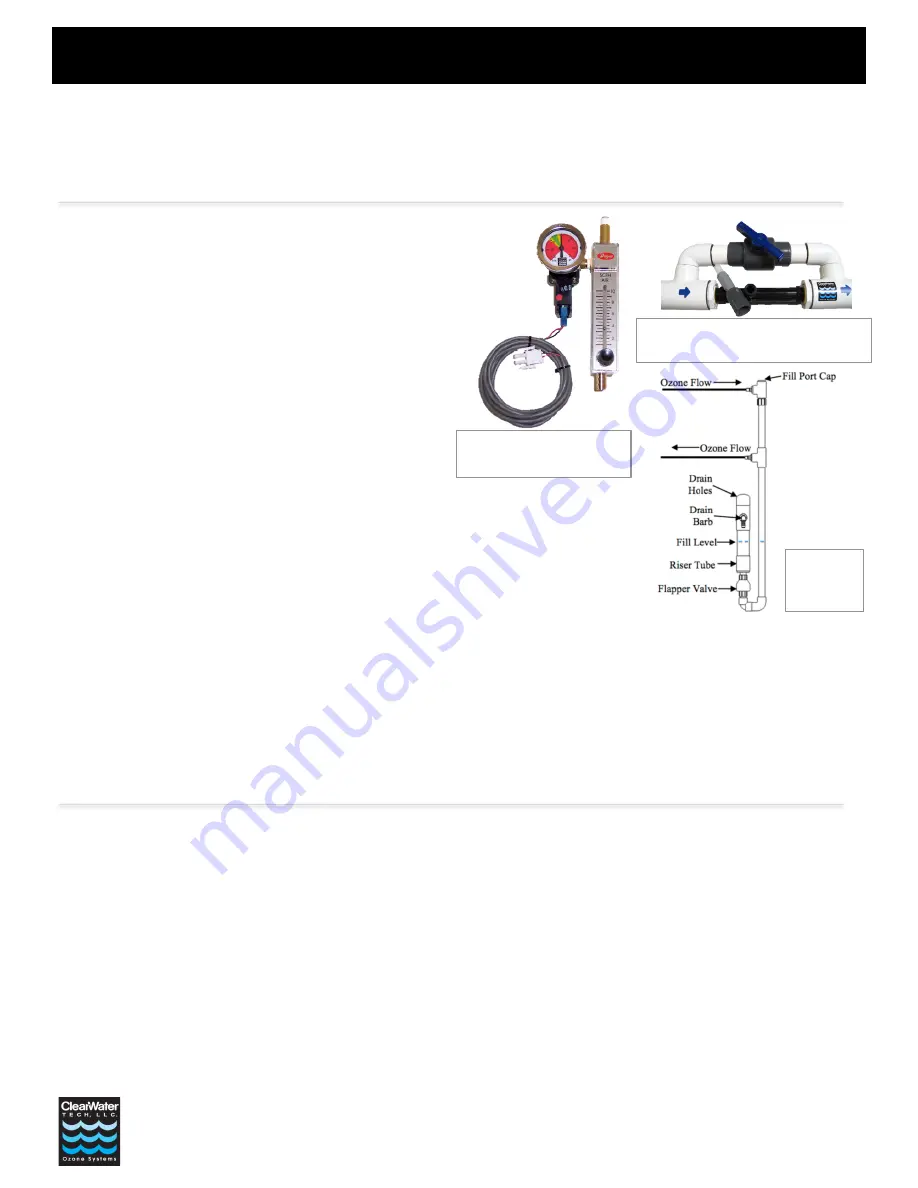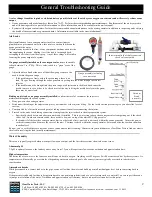
General Troubleshooting Guide
2
ClearWater Tech, LLC.
Toll Free: 1.800.262.0203 • Ph: 805.549.9724 • Fax: 805.549.0306
850-E Capitolio Way, San Luis Obispo, CA 93401 • email: service@cwtozone.com • www.cwtozone.com 110613
A color change from blue to pink or white indicates a possible failure of the air dryer or oxygen concentrator and will severely reduce ozone
output.
•
Ozone generators with model numbers that end in “/AD”: Perform the recommended annual maintenance. Replacement of the air dryer media
and all indicating media is a part of this maintenance. More information would be available in the unit’s manual.
•
Systems with oxygen concentrators: Perform the recommended annual maintenance to the ozone generator in addition to inspecting and verifying
the health of the associated oxygen concentrator. Information is available in the associated manual.
Air Leaks
Most installations of our ozone generators involve a venturi injector
plumbed into a pressurized water line; this creates a suction that draws the
ozone gas into the water.
If there are any breaks in the line, or any component, ambient air enters the
line supplanting the ozone, diluting it or if the leak is far enough back,
corrupting the dried air from the air prep. Any of these things will result in
lowering the ozone output of a system.
If a gauge assembly installed on the ozone generator
, insure the needle
is kept between -3 to -8”Hg. This is color-coded to a “green” area of the
gauge.
•
Adjust the black knob at the base of the airflow gauge to move the
needle within the green range.
o
If the needle moves freely within the green range, there is no
leak. The gas flowing through the ozone generator is getting into the water through the venturi
injector.
o
If the needle cannot be brought into the green range, or adjustments to the black knob cause the
needle to move to zero (it has to be closed most of the way to bring the needle barely into the green)
there may be an air leak.
Finding an air leak, or no gauge assembly installed,
confirm the level of vacuum at the injector is
maintained throughout the ozone system.
•
Deny power to the ozone generator.
•
Disconnect the tubing at the injector and place your thumb over the injector fitting. Use the tactile suction present to give you a baseline level of
suction.
•
Compare this level of suction to each point of tubing connections after reconnecting the injector.
•
Proceed to the end of each tubing connection starting from the injector back to the air preparation system.
o
Specifically check before and after vacuum break, if installed. This is a water trap to keep the ozone generator from getting wet if the check
valves fail. In order to remain sealed, there needs to be water on top of the white PVC flapper valve.
o
If vacuum is felt before the ozone generator, but is not detected after it; our leak is obviously within the ozone generator. Insure the power
cord is disconnected and remove the cover of the unit. Continue to check within the ozone generator, before and after the reaction chambers
is an ideal test.
By now, you’ve verified there are no leaks or have found an area that is leaking. Consult with your distributor or ClearWater Tech to find out what is
involved in resolving the leak (usually maintenance).
Water Chemistry
This area is typically explored when we suspect low ozone output, and the first three sections show to have no issues.
Abnormal pH
7.2 pH is optimal for ozone, the farther you are away from 7.2 you will experience lower ozone oxidation and ppm retention time.
Higher temperature
The hotter the air or water is, the faster ozone will convert back to oxygen. Anything over 85 degrees F will be considered 'hot' by these systems. As
temperatures will normally go over this level depending on season or heated pools, all ozone systems are typically oversized to take this into
consideration.
Atmospheric breaks
While pressurized in a contact tank or in the pipe, ozone will oxidize the water and build up a small residual ppm level before converting back to
oxygen.
If the pressure is suddenly lost due to being introduced to an open (atmospheric) tank or a water feature such as a waterfall, we can expect the ozone
to jump out of solution of the water. Oxidation and ppm retention will continue, but at a reduced level in and after this point.
Vacuum
break
assembly
Gauge assembly including
vacuum switch
Injector manifold with disconnected
check valve assembly




















